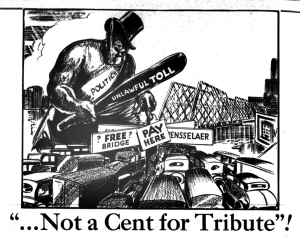 For the longest time, it’s been said that the Dunn Memorial Bridge is the southernmost toll-free crossing of the Hudson River (which is saying something, being that it’s 145 miles from Albany to the Battery). But that wasn’t always the case.
For the longest time, it’s been said that the Dunn Memorial Bridge is the southernmost toll-free crossing of the Hudson River (which is saying something, being that it’s 145 miles from Albany to the Battery). But that wasn’t always the case.
Its predecessor, the Greenbush Bridge, was constructed as a private project in 1882 by the Albany & Greenbush Bridge Company, which ended up in the hands of the Albany Southern Railroad, the streetcar line (and more – it also provided electricity and gas); it bought the bridge for $600,000 in 1909. In all those years, there were tolls, and frequently there was agitation against those tolls. That agitation grew as automobile traffic did. In the second decade of the 20th century, there was a move to have the State of New York take over the bridge and remove the tolls, with several legislative proposals. The Columbia Republican (Hudson, NY) lamented in February of 1916:
A traveler may go from San Francisco to Boston over free highways and cross innumerable bridges without paying a cent of toll until he gets to the doorway of the capital of the Empire state, when the Albany Southern Railroad company will hold him up on a free state highway route and demand payment before he can cross the Hudson river. This is the condition described at the hearing on the bill of Assemblyman John G. Malone of Albany which would provide a method for the state to take over the Greenbush and any other bridges which form connecting links on state highway routes.
(Locally, the toll bridges included the Congress Street bridge between Watervliet and Troy.)
The Albany Southern didn’t think much of this proposal, although the company itself didn’t then run trains or trolleys over it (United Traction Company held a contract to run trolleys). There had always been a potential plan to add a full rail crossing on an upper deck of the bridge, which they argued was just about to happen as they were in negotiations with the Rutland railroad to extend its line to Pittsfield. The Albany Southern thought the Delaware and Hudson was behind the bill to prevent the competition. They worried that when the state took over, it might refuse to let the railroad use the bridge, or charge a high rent.
The debate continued into 1917; in March, the president of the Albany Chamber of Commerce, J.Y. Read, called the situation a disgrace to the entire state. Calling it the busiest traffic center in the state outside of New York City, Read said that
It has been estimated by competent observers that approximately 300,000 automobiles crossed this bridge last year. In addition there were horse-drawn vehicles and pedestrians, and every vehicle and pedestrian crossing this bridge was held up by the owners of the bridge and obliged to pay tribute in the form of a toll charge.
The boast of the State of New York is that she has spent millions and millions of dollars for the development of her highway system and that her roads are free to the world, and yet right at the steps of the State Capitol every tourist who crosses the Hudson River is held up by a private corporation and charged for the privilege of traversing the State highways.
The battle, of course, wasn’t just over the Greenbush bridge; the question was whether the State should take over all toll bridges crossing navigable streams and connecting highway lines. Eventually, that was decided, and in 1919 the state bought the bridge for $890,000, and thus ended the discussion of tolls between Albany and Rensselaer.
No, of course that didn’t end it. When it came time to replace the Greenbush bridge with what would be the Dunn Memorial Bridge, there was legislation that would have assessed a charge against both Albany and Rensselaer counties to pay for the bridge, or at least the approaches. That prompted the cartoon seen above, which featured in a 1931 ad in the Albany Evening News, signed by Rensselaer luminaries such as the Bayer Company and F.C. Huyck, which proclaimed:
We in Rensselaer do not believe that we ought to be assessed a toll to travel the Albany-Rensselaer Bridge. That, in effect, is what we would be required to do under the Whitney bill providing for a twelve and one-half percent bridge charge against the county. You men in the Legislature – if you pass this highly undesirable and unfair bill – will be taking away a free bridge made so by statute, and substituting therefor a structure for which we will have to pay in order to cross. That is contrary to law, contrary to public policy. The statute specifically provided that when the State bought the Greenbush bridge it should be free forever.
It’s not clear that the powers of Rensselaer had their way. A 1933 article on the opening of the bridge noted that in a “compromise,” the cost to Albany county was eliminated, but the cost to Rensselaer wasn’t mentioned. Neverthless, it wasn’t a toll per se, and traffic was relieved.
